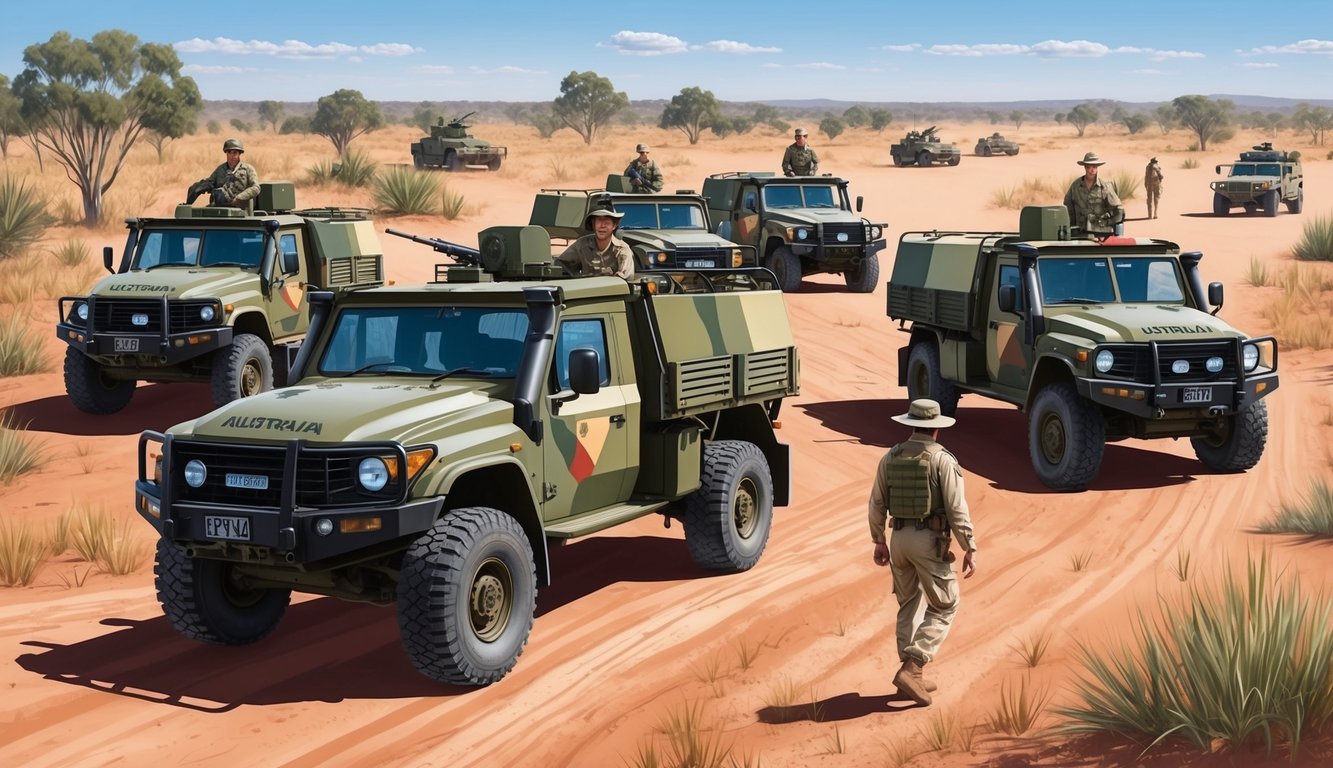The military of Australia plays an essential role in protecting the nation’s interests and bolstering global security.
The Australian Defence Force (ADF) is made up of three branches: the Royal Australian Navy, Australian Army, and Royal Australian Air Force. As of 2024, the ADF is recognized as the 16th most powerful military in the world, with a personnel strength exceeding 89,000.
It may come as a surprise, but Australia’s military is experiencing its most profound transformation since World War II.
The government has recently approved a significant defense strategy shift to meet the evolving challenges of modern warfare.
This change underscores Australia’s dedication to maintaining a robust and capable defense force amid a rapidly changing global environment.
Australia’s military engagement extends beyond national protection; it actively participates in international alliances and missions.
The ADF is involved in various multinational exercises and peacekeeping operations, reflecting its commitment to global stability and cooperation.
Key Takeaways
- The Australian Defence Force consists of the Navy, Army, and Air Force, employing over 89,000 personnel.
- The ADF is currently undergoing a significant strategic transformation to address contemporary warfare challenges.
- Australia’s military actively engages in international alliances and operations, contributing to global security initiatives.
Historical Overview
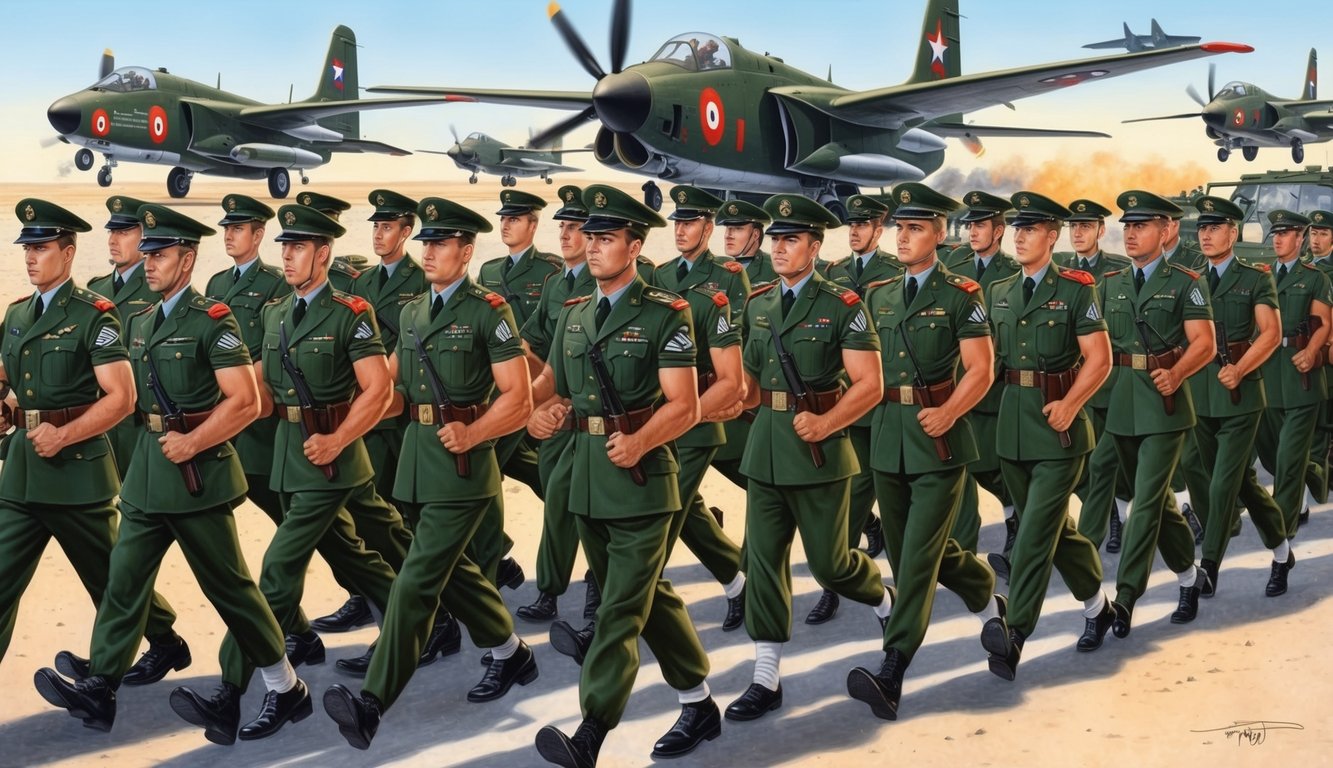
The Australian military boasts a rich history spanning more than two centuries.
It is intriguing to observe how the armed forces have evolved and participated in major global conflicts.
Origins and Military History
The origins of Australia’s military date back to colonial times.
Before the federation in 1901, each colony maintained its own military forces.
The Defence Act of 1903 unified these forces into a national military.
During World War I, the Australian Imperial Force (AIF) was established, marking a significant milestone in the military’s development.
The legend of ANZAC (Australian and New Zealand Army Corps) emerged at Gallipoli in 1915.
In World War II, Australian forces fought in multiple theaters, playing critical roles in North Africa, Europe, and the Pacific.
Major Conflicts
Following World War II, Australia’s military continued to evolve, participating in several significant conflicts.
The Korean War (1950-1953) marked Australia’s first involvement in a United Nations action, with troops fighting alongside allies against North Korean and Chinese forces.
The Vietnam War (1962-1975) was a controversial period when Australia deployed troops to support South Vietnam and the United States, sparking intense debates over conscription.
In more recent history, Australia joined coalition forces in the War in Afghanistan (2001-2021), with military contributions encompassing peacekeeping, combat, and training operations throughout this prolonged engagement.
These conflicts have shaped the structure, tactics, and global role of the Australian military.
Structure and Organization
The structure of the Australian military is clearly defined, ensuring effective defense and national security.
It features distinct branches, clear leadership roles, and a hierarchical rank system to facilitate smooth operations.
Defence Ministry and Leadership
At the helm of Australia’s military structure is the Minister for Defence, a civilian leader who oversees the entire defense organization and reports directly to the Prime Minister.
Collaborating closely with the Minister is the Department of Defence, responsible for administrative and policy-related matters.
The Chief of the Defence Force (CDF) holds the highest military rank, advising the government on military issues and commanding the ADF.
Each branch of the ADF also has its own chief, such as the Chief of Army, reporting to the CDF.
Branches of the Australian Defence Force
The ADF consists of three principal branches:
- Australian Army
- Royal Australian Navy (RAN)
- Royal Australian Air Force (RAAF)
Each branch possesses its own structure and specialties: the Army focuses on land operations, the Navy oversees maritime defense, and the Air Force is responsible for aerial warfare and defense.
These branches frequently collaborate in joint operations, highlighting the importance of coordination in Australia’s overall defense strategy.
Ranks and Insignia
The ADF employs a rank system similar to other Commonwealth militaries, with distinct ranks for officers and enlisted personnel across all branches.
Here is an overview of some key ranks:
Army:
- Private (lowest enlisted rank)
- Sergeant
- Lieutenant
- Colonel
- General (highest rank)
Navy:
- Seaman
- Petty Officer
- Lieutenant
- Captain
- Admiral
Air Force:
- Aircraftman/Aircraftwoman
- Sergeant
- Flight Lieutenant
- Group Captain
- Air Marshal
Each rank features unique insignia displayed on uniforms, helping to quickly identify individuals’ positions and authority within the military framework.
Strategic Defence
Australia’s defense strategy is evolving significantly in response to regional dynamics.
The government has launched new initiatives to enhance national security and prepare for forthcoming challenges in the Indo-Pacific region.
Defence Strategic Review
The 2023 Defence Strategic Review represents a pivotal change in Australia’s military stance, proposing 108 recommendations aimed at reshaping defense capabilities.
It prioritizes long-range strike capabilities and naval enhancements, with a focus on preparing for potential conflicts in the missile age.
Climate change considerations are also addressed, with plans for the adaptation of military infrastructure and operations.
The government has pledged to increase defense spending to carry out these initiatives, with anticipated investments in advanced technologies and cybersecurity to counter new threats.
Australia’s Military Strategy
The current military strategy centers on a concept termed “strategy of denial,” aimed at deterring potential adversaries by making aggression too costly.
There is a growing emphasis on enhancing power projection throughout the Indo-Pacific region.
The 2024 National Defence Strategy builds on this basis, outlining plans to solidify alliances and promote regional collaboration.
Expect more joint exercises with partners such as the US, Japan, and India.
The military is also adapting to emerging challenges, developing capabilities to counter grey-zone tactics and hybrid warfare.
Increased investment in space and cyber capabilities is likely as Australia modernizes its forces to confront 21st-century conflicts.
Military Assets
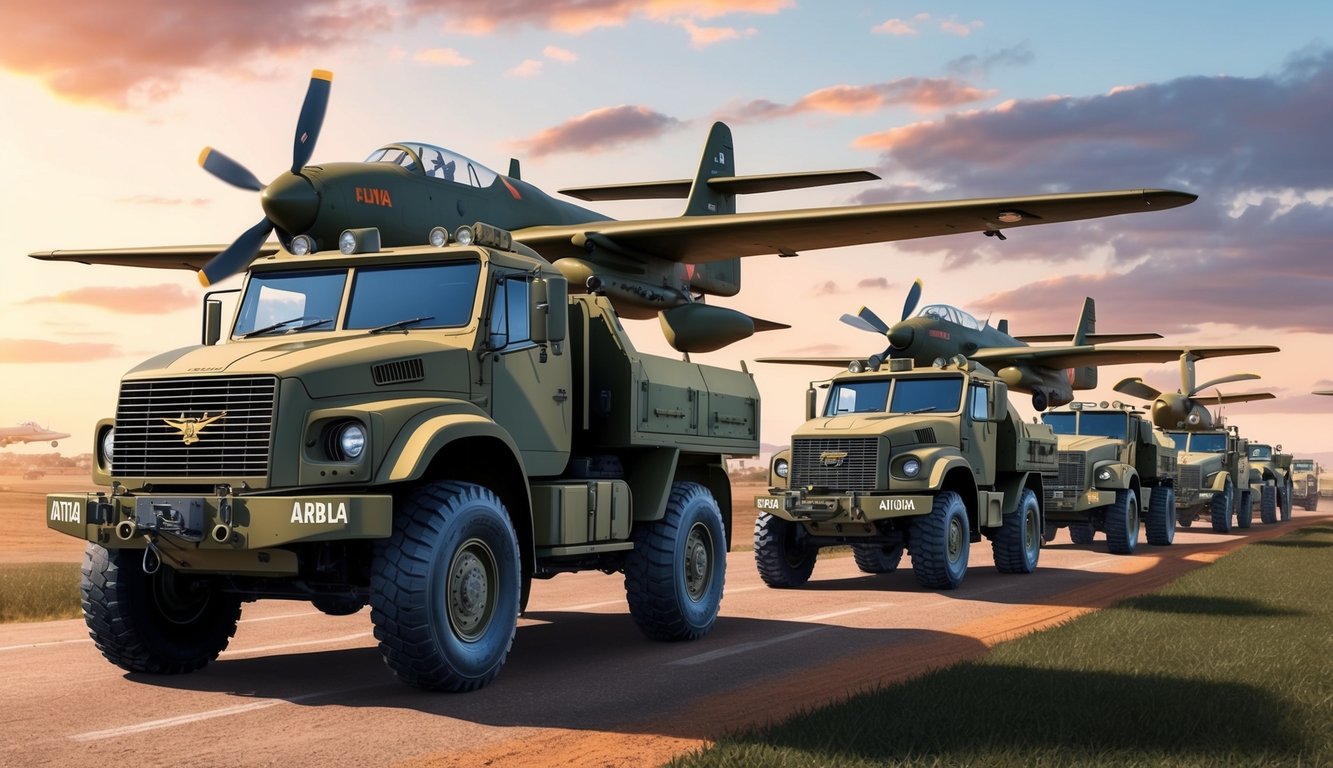
Australia maintains a diverse and advanced military force designed to safeguard its interests and enhance regional security.
Let’s delve into the key assets across land, sea, and air that constitute Australia’s defense capabilities.
Land Forces and Equipment
The Australian Army utilizes a variety of cutting-edge vehicles and weaponry.
The M1A1 Abrams main battle tank serves as the backbone of armored combat, providing essential firepower and protection in the field.
For infantry mobility, the Army relies on the Bushmaster Protected Mobility Vehicle, a versatile troop carrier known for its robust protection against mines and improvised explosive devices.
Artillery assets include the M777 lightweight howitzer, a 155mm artillery piece that delivers precise long-range fire support.
Australian soldiers are equipped with the EF88 Austeyr rifle, a locally manufactured version of the Steyr AUG, offering compact handling and reliability in challenging environments.
Naval Vessels and Submarines
The Royal Australian Navy operates a fleet of modern surface combatants and submarines.
The Hobart-class air warfare destroyers provide cutting-edge naval defense capabilities, capable of engaging multiple targets simultaneously.
The ANZAC-class frigates form the essential core of Australia’s surface fleet, excelling in anti-submarine warfare and maritime patrol missions.
Underwater, the Collins-class submarines grant Australia significant stealth and long-range capabilities, recognized for their effectiveness.
The Navy is also preparing for the future by procuring nuclear-powered submarines through the AUKUS partnership, which will greatly enhance Australia’s undersea warfare capabilities.
Air Force and Aircraft
The Royal Australian Air Force (RAAF) operates a state-of-the-art fleet comprising combat and support aircraft.
The F/A-18F Super Hornet is the primary fighter jet, capable of engaging both air and ground targets with high precision.
For air superiority, the RAAF employs the F-35A Lightning II, a fifth-generation stealth fighter representing the pinnacle of contemporary air combat technology.
Maritime patrol duties are conducted using the P-8A Poseidon, which excels in submarine hunting and long-range surveillance over extensive ocean areas.
Strategic airlift capabilities are provided by the C-17A Globemaster III, which can swiftly deploy troops and equipment over great distances.
For aerial refueling, the KC-30A Multi-Role Tanker Transport enhances the range and endurance of other aircraft, also serving in transportation and emergency medical evacuation roles.
International Engagement and Operations
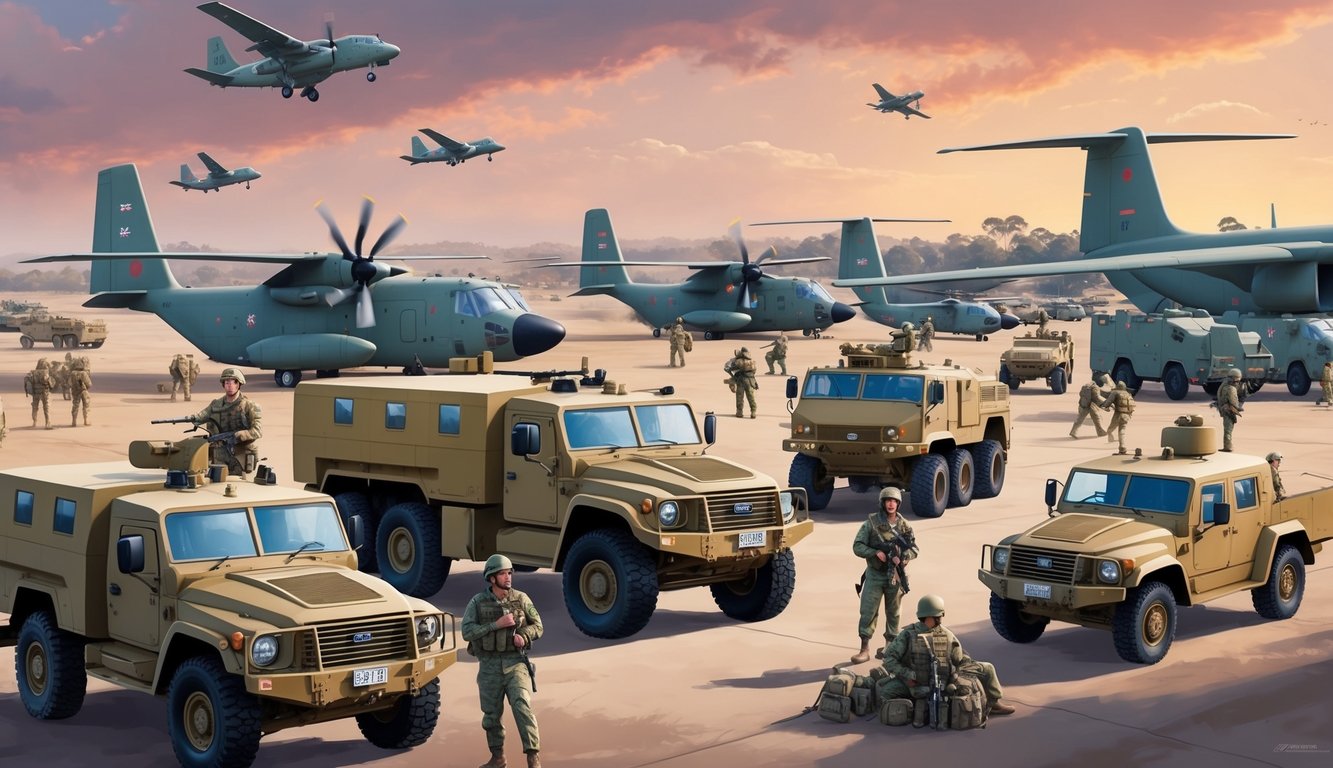
The military of Australia plays a significant role in regional and global affairs, as the Australian Defence Force (ADF) actively engages in peacekeeping operations and strengthens alliances while adapting to modern military challenges in the Indo-Pacific region.
Peacekeeping and Alliances
The ADF has a longstanding tradition of international engagement, with Australian troops deployed on peacekeeping missions around the globe, contributing to overall stability.
The military nurtures strong alliances with partners such as the United States and regularly engages in joint exercises for enhanced interoperability.
Australia-Singapore collaboration exemplifies this partnership.
During the 2022 New South Wales floods, Singaporean Chinook helicopters provided assistance, highlighting the practical benefits of such alliances.
The ADF also collaborates with Pacific Island nations to promote regional security and diplomatic relations.
Modern Military Challenges
Australia’s national interests are paramount in ADF operations, focusing on the protection of Australia’s borders and offshore maritime interests.
This includes addressing threats such as terrorism, cybersecurity vulnerabilities, and potential regional conflicts.
The unique challenges of the Indo-Pacific region necessitate the ADF to adapt its strategies to respond to the evolving geopolitical landscape.
This involves upgrading equipment, enhancing cyber capabilities, and refining tactics for potential major conflicts.
The ADF also plays a vital role in humanitarian assistance and disaster relief missions, reinforcing Australia’s reputation as a responsible regional power while fostering international goodwill.
Culture and Traditions
The Australian Defence Force (ADF) embodies a rich heritage of customs and values that shape its identity.
These traditions significantly influence military life and leave a profound impact on Australian society.
Military Customs and Values
Deeply rooted in British heritage, ADF culture reflects numerous customs, such as the Rising Sun badge and the Dawn Service.
The ANZAC spirit, which originated during the Gallipoli campaign in World War I, symbolizes values such as mateship, courage, and sacrifice.
Leadership within the military emphasizes integrity, teamwork, and resilience, qualities instilled through rigorous training and reinforced daily.
Ceremonial traditions hold significant importance, such as catafalque parties standing vigil at memorials or the playing of the Last Post during remembrance events.
Influence on Australian Society
The ADF’s culture influences the broader Australian identity.
You can observe its presence in national celebrations and memorials.
ANZAC Day, celebrated on April 25th, stands as a vital day of remembrance for all Australians.
Military values frequently translate into civilian life; for instance, the concept of mateship is widely embraced across society.
This is reflected in community support initiatives during emergencies or natural disasters.
The ADF’s focus on leadership and teamwork resonates in corporate culture and sports teams nationwide.
Many organizations adopt similar principles to cultivate unity and achieve common objectives.
Military traditions also inspire artistic representations, with numerous books, films, and artworks celebrating Australia’s military heritage, preserving these narratives for future generations.
Media and Communications
The relationship between the Australian military and media has undergone considerable transformation.
Various methods, both traditional and modern, shape how the armed forces interact with the public and manage information.
Coverage by Major Networks
Major media networks, such as CNN, BBC World Service, and Australian outlets, play an integral role in military reporting.
Coverage includes operations, peacekeeping missions, and debates on defense policy.
International agencies like Reuters, AFP, and APTN contribute to global awareness of Australian military activities.
The Australian Defence Force (ADF) collaborates with these networks to ensure access to information.
You might notice embedded journalists during operations, delivering firsthand accounts to the public.
Information Dissemination and Copyright
The ADF employs various platforms to communicate directly with you.
Social media is increasingly essential for sharing updates regarding exercises, deployments, and community involvement.
Copyright regulations are significant when managing military information.
Awareness of potential restrictions on certain content is crucial.
The ADF often publishes materials under specific terms, balancing transparency with security considerations.
Time zones can also affect the speed of information dissemination.
Official communications utilize Australian Eastern Standard Time (AEST), although GMT may be used for international coordination.
Frequently Asked Questions
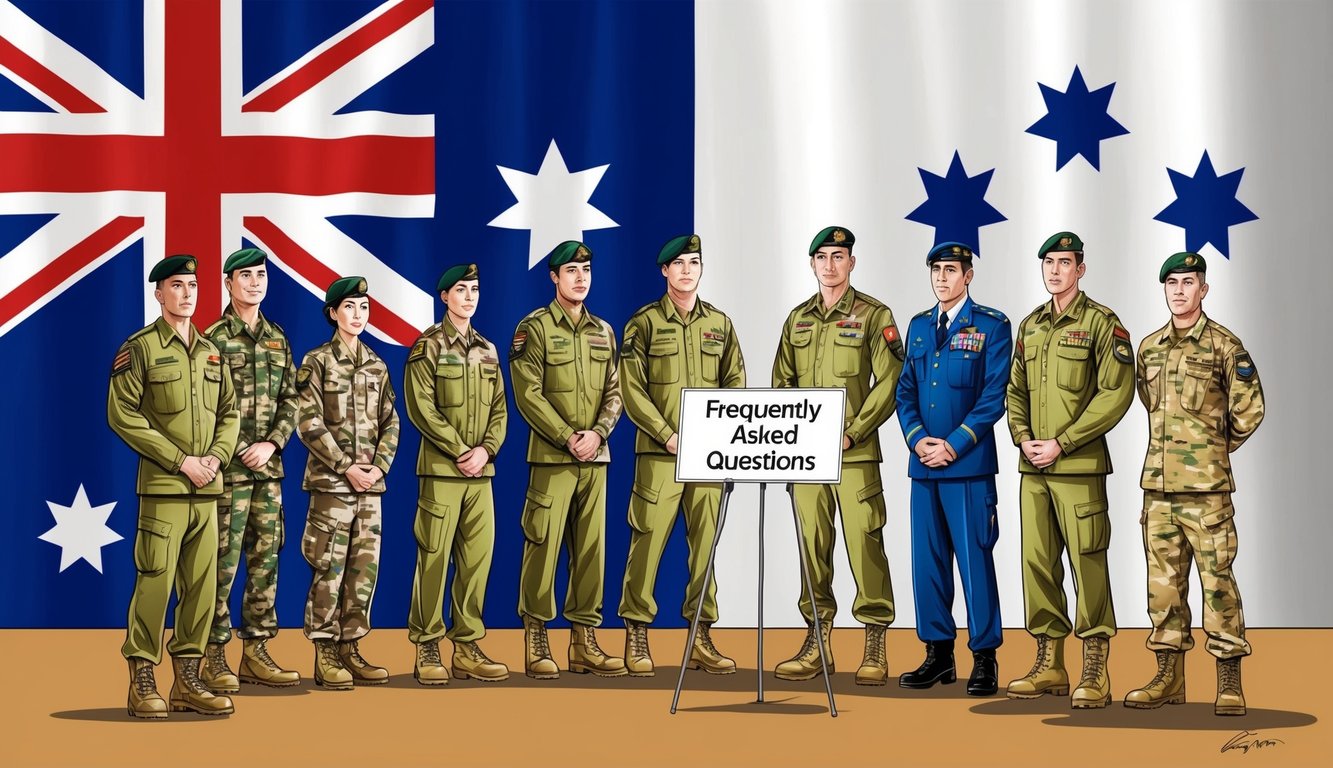
The Australian Defence Force provides a diverse range of career opportunities and supports critical operations both domestically and internationally.
Enlisting in the ADF involves specific steps and requirements, with each branch structured to meet Australia’s distinct defense needs.
What are the different ranks in the Australian military?
The Australian military employs a hierarchical rank structure.
In the Army, enlisted ranks begin with Private and culminate in Warrant Officer, while officer ranks start at Lieutenant and extend to General.
The Navy and Air Force have parallel structures but use different titles.
For example, the Navy designates Able Seaman instead of Private, and the Air Force designates Aircraftman/Aircraftwoman.
How much does someone in the Australian Army earn?
Salaries in the Australian Army vary based on rank and experience.
A new recruit during basic training earns around $49,000 per year, while a Private’s salary starts at approximately $62,000 annually after training.
Officers begin at higher pay grades, with a Lieutenant earning about $74,000 per year.
These figures represent base salaries excluding additional allowances or benefits.
What steps are involved in joining the Australian Defence Force?
Joining the ADF begins with an online application.
Following that, you will attend a You Session to assess your aptitudes and explore career options.
You’ll then undergo medical and fitness evaluations.
If successful, you’ll participate in an Assessment Session that includes interviews and further testing before receiving a job offer and enlistment date.
The entire process typically spans several months.
What kind of support does the Australian Army provide in aid situations?
The Australian Army plays a vital role in disaster relief and humanitarian aid, assisting in evacuations during bushfires and floods.
Army personnel engage in search and rescue operations and provide emergency medical care.
On international aid missions, the Army contributes to peacekeeping operations and delivers supplies to areas affected by disasters, also aiding in the reconstruction of infrastructure.
Can a non-Australian citizen enlist in the Australian Army?
Typically, one must be an Australian citizen to enlist in the Australian Army, though exceptions exist for permanent residents.
The ADF sometimes recruits overseas applicants with specialized skills.
If you are a New Zealand citizen residing in Australia, you may also be eligible for application.
Detailed information on citizenship requirements for enlistment can be found on the ADF website.
What capabilities do the Australian Air Force possess?
The Royal Australian Air Force (RAAF) maintains a modern fleet of aircraft, including fighter jets such as the F-35A Lightning II and F/A-18F Super Hornet for combat roles.
For logistics and transport, the RAAF operates the C-17A Globemaster III and C-130J Hercules aircraft.
The P-8A Poseidon serves maritime patrol missions, alongside various helicopters for diverse operational needs.

